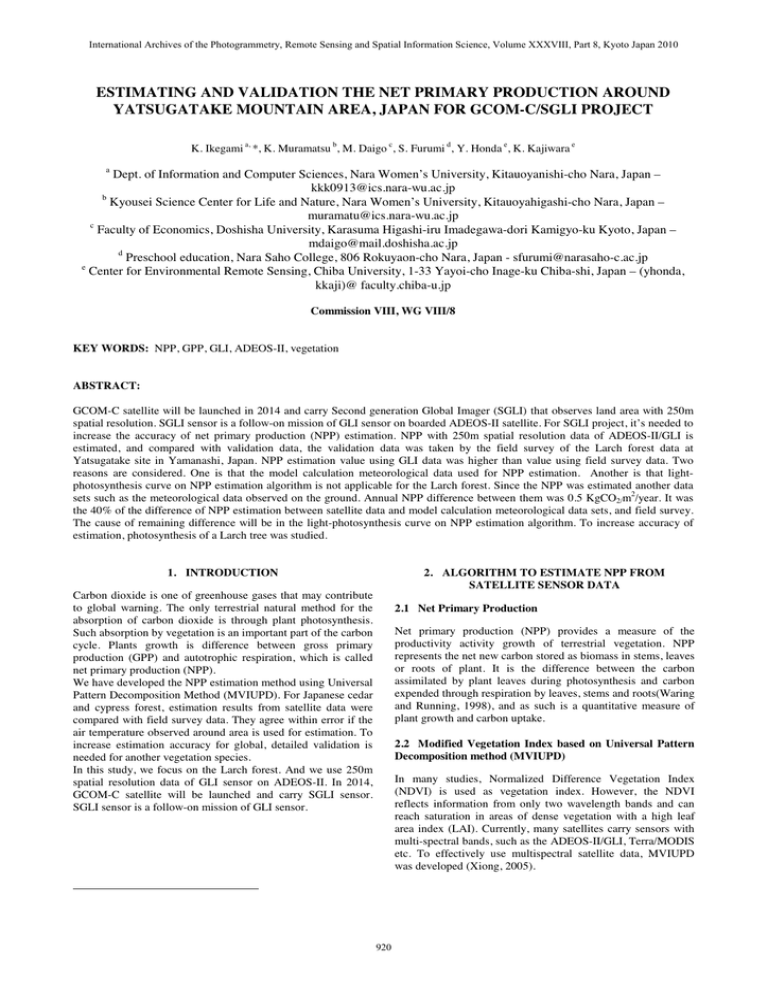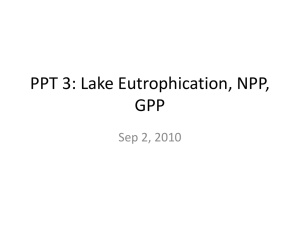ESTIMATING AND VALIDATION THE NET PRIMARY PRODUCTION AROUND
advertisement

International Archives of the Photogrammetry, Remote Sensing and Spatial Information Science, Volume XXXVIII, Part 8, Kyoto Japan 2010 ESTIMATING AND VALIDATION THE NET PRIMARY PRODUCTION AROUND YATSUGATAKE MOUNTAIN AREA, JAPAN FOR GCOM-C/SGLI PROJECT K. Ikegami a, *, K. Muramatsu b, M. Daigo c, S. Furumi d, Y. Honda e, K. Kajiwara e a Dept. of Information and Computer Sciences, Nara Women’s University, Kitauoyanishi-cho Nara, Japan – kkk0913@ics.nara-wu.ac.jp b Kyousei Science Center for Life and Nature, Nara Women’s University, Kitauoyahigashi-cho Nara, Japan – muramatu@ics.nara-wu.ac.jp c Faculty of Economics, Doshisha University, Karasuma Higashi-iru Imadegawa-dori Kamigyo-ku Kyoto, Japan – mdaigo@mail.doshisha.ac.jp d Preschool education, Nara Saho College, 806 Rokuyaon-cho Nara, Japan - sfurumi@narasaho-c.ac.jp e Center for Environmental Remote Sensing, Chiba University, 1-33 Yayoi-cho Inage-ku Chiba-shi, Japan – (yhonda, kkaji)@ faculty.chiba-u.jp Commission VIII, WG VIII/8 KEY WORDS: NPP, GPP, GLI, ADEOS-II, vegetation ABSTRACT: GCOM-C satellite will be launched in 2014 and carry Second generation Global Imager (SGLI) that observes land area with 250m spatial resolution. SGLI sensor is a follow-on mission of GLI sensor on boarded ADEOS-II satellite. For SGLI project, it’s needed to increase the accuracy of net primary production (NPP) estimation. NPP with 250m spatial resolution data of ADEOS-II/GLI is estimated, and compared with validation data, the validation data was taken by the field survey of the Larch forest data at Yatsugatake site in Yamanashi, Japan. NPP estimation value using GLI data was higher than value using field survey data. Two reasons are considered. One is that the model calculation meteorological data used for NPP estimation. Another is that lightphotosynthesis curve on NPP estimation algorithm is not applicable for the Larch forest. Since the NPP was estimated another data sets such as the meteorological data observed on the ground. Annual NPP difference between them was 0.5 KgCO2/m2/year. It was the 40% of the difference of NPP estimation between satellite data and model calculation meteorological data sets, and field survey. The cause of remaining difference will be in the light-photosynthesis curve on NPP estimation algorithm. To increase accuracy of estimation, photosynthesis of a Larch tree was studied. 2. ALGORITHM TO ESTIMATE NPP FROM SATELLITE SENSOR DATA 1. INTRODUCTION Carbon dioxide is one of greenhouse gases that may contribute to global warning. The only terrestrial natural method for the absorption of carbon dioxide is through plant photosynthesis. Such absorption by vegetation is an important part of the carbon cycle. Plants growth is difference between gross primary production (GPP) and autotrophic respiration, which is called net primary production (NPP). We have developed the NPP estimation method using Universal Pattern Decomposition Method (MVIUPD). For Japanese cedar and cypress forest, estimation results from satellite data were compared with field survey data. They agree within error if the air temperature observed around area is used for estimation. To increase estimation accuracy for global, detailed validation is needed for another vegetation species. In this study, we focus on the Larch forest. And we use 250m spatial resolution data of GLI sensor on ADEOS-II. In 2014, GCOM-C satellite will be launched and carry SGLI sensor. SGLI sensor is a follow-on mission of GLI sensor. 2.1 Net Primary Production Net primary production (NPP) provides a measure of the productivity activity growth of terrestrial vegetation. NPP represents the net new carbon stored as biomass in stems, leaves or roots of plant. It is the difference between the carbon assimilated by plant leaves during photosynthesis and carbon expended through respiration by leaves, stems and roots(Waring and Running, 1998), and as such is a quantitative measure of plant growth and carbon uptake. 2.2 Modified Vegetation Index based on Universal Pattern Decomposition method (MVIUPD) In many studies, Normalized Difference Vegetation Index (NDVI) is used as vegetation index. However, the NDVI reflects information from only two wavelength bands and can reach saturation in areas of dense vegetation with a high leaf area index (LAI). Currently, many satellites carry sensors with multi-spectral bands, such as the ADEOS-II/GLI, Terra/MODIS etc. To effectively use multispectral satellite data, MVIUPD was developed (Xiong, 2005). 920 International Archives of the Photogrammetry, Remote Sensing and Spatial Information Science, Volume XXXVIII, Part 8, Kyoto Japan 2010 MVIUPD = Cv − Cw − 0 .2 × Cs − C 4 Cw + Cv + Cs with a wavelength range of 400 nm to 700 nm and MVIUPD. In this formula, t is time. P(PAR(t), MVIUPD(t)) are expressed approximately as follows, (1) P (PAR (t ), MVIUPD (t ) ) = Cw, Cv, Cs and C4 are derived the Universal Pattern Decomposition Method (UPDM). UPDM allows sensorindependent spectral analysis to derive the same coefficient values for the spectral bands on different sensors. Each pixel (P(i)) is represented as a linear sum of standard spectral patterns. i corresponds to the wavelength bands and Eq. (2) below shows the conversion process. MVIUPD (t ) × Pstd (PAR (t ) ). MVIUPDstd (6) MVIUPDstd is determined from ground measurement reflectance data. Pstd(PAR(t)) [mgCO2/m2s] is the lightphotosynthetic curve, expressed as follows, P (i ) → Cw × Pw (i ) + Cv × Pv (i ) + Cs × Ps (i ) + C 4 × P 4(i ) Pstd (PAR (t ) ) = (2) Here, Cw, Cv and Cs are the decomposition coefficients of water, vegetation, and soil respectively. C4 represents the coefficients for the supplementary pattern of ayellow leaf. Pw(i), Pv(i), Ps(i), and P4(i) are the standard spectral patterns for water, vegetation, soil and the supplementary yellow leaf pattern for band i. In Eq. (1), (Cw+Cv+Cs) represents the sum of the total reflectance, and Cw forces MVIUPD values to e negative over surface that lack vegetation, such as snow covered area. The coefficient 0.2 with Cs was determined so that the error from the relationships of MVIUPD for vegetation photosynthesis and cover ratio became the smallest. P max × b × PAR (t ) . 1 + b × PAR (t ) (7) Pmax is the maximum photosynthesis in a saturated region and b is the degree of the light-photosynthetic curve. From Eq. (7), it is clearly that photosynthesis increases as PAR becomes stronger within low PAR, but photosynthesis gradually approaches Pmax when PAR becomes infinite. The b shows the curve as b increases and the increase in PAR leads rapidly to photosynthetic saturation. The ratio of PAR to global solar tradition is relatively constant for daily time scales (Britton and Dodd, 1976) and a common approach is therefore to derive PAR radiation from estimates of global solar radiation (Tarpley, 1979; Gautier et al., 1980; Cano et al., 1986; Beyer et al., 1996). 2.3 Algorithm to estimate NPP by vegetation indices PAR = 0 .48 × SW , In this algorithm, NPP can be calculated by subtracting the vegetation autotrophic respiration (Rd) from the gross primary production (GPP) (Box et al., 1989; Gower et al., 1999; Liu et al., 1999), as expressed by the following: NPP = GPP − Rd . (8) Pmax where SW is the solar radiance. Thus, solar radiance data are used to calculate mean PAR data in some period over 24 hours. However, GPP is overestimated when mean PAR over 24 hours is used because plants photosynthesize only during the daytime. The time-integral of photosynthesis using mean PAR over the effective day length of vegetation photosynthesis (h) is approximated (Xiong, 2005). This length is defined as follows: (3) The autotrophic respiration (Rd) of vegetation represents the rate of carbon return from live vegetation to the atmosphere, and is calculated from GPP and air temperature, which has been cited by many studies (Chang, 1970) using the following empirical equation, h = H − 2 .0 , (9) where H is the time between sunrise and sunset. 7 .825 + 1 .145 T [ o C ] Rd = × GPP . 100 (4) 3. STUDY AREA AND FIELD SURVEY For getting validation data, the Larch forest was surveyed at Yatsugatakesite in Yamanashi, Japan. The GPP is the rate of atmosphere carbon fixation by vegetation. To estimate GPP from multi-spectral data, Eq. (5) is developed (Furumi et al., 2005a). GPP = ³ P (PAR (t ), MVIUPD (t ) )dt 3.1 Yatugatake site Yatsugatake site is in Kobuchizawa Hokuto-shi Yamanashi, Japan. The altitude is 1270m. The survey area is about 1200 m2, and the diagonal degree is 5.8 o. The larch has grown in the area at rate of 700/ha. Every tree’s diameter of breast height (D. B. H) and height of tree were measured. I got data from 2001 to 2008. These data provided by Chiba Univ. The average of the (5) This formula expresses gross photosynthesis (P [mgCO2]) as a function of the photosynthetically active radiation (PAR[ W/m]) 921 International Archives of the Photogrammetry, Remote Sensing and Spatial Information Science, Volume XXXVIII, Part 8, Kyoto Japan 2010 height of tree is 24.6m, and the average of Diameter of Brest Height (D.B.H.) is 27.1cm in 2008. 4.3 Result The monthly NPP from February to October in 2003 was estimated. Figure 2 is the result of the NPP estimation around Yatsugatake mountain area in August. And annual NPP in 2003 was estimated. The annual NPP of Yatsugatake site in 2003 was 2.42±0.62 kgCO2/m2/year. 3.2 Estimating NPP The stem timber volume (V [m3]) was estimated from D. B. H. (d [cm]) and height (h [m]) data using the formula of the stem timber volume method (J-FIC, 1970): log V = −5 + 0.67205 + 1 .84173 log d + 1.1108 log h (10) Total volume of a tree is estimated by the proportion of whole of a tree to the stem. The growth volume of a tree was cemented to the mass using the volume density, 09±1.3kg/m3. The annual NPP of Larch forest was 1.16±0.24 kgCO2/m2/year in average from 2001 to 2008. 4. NPP ESTIMATION FROM ADEOS-II/GLI 0.0 ADEOS-II/GLI 250m spatial resolution data were used to estimate the NPP, using meteorological data including solar radiation data, air temperature. 0.8 [kgCO2/m2/year] Figure 2: NPP on August in 2003 around Yatsugatake mountain, Japan. 4.1 Satellite data The vegetation index MVIUPD was computed from ADEOSII/GLI 250m spatial resolution data. From February to October in 2003, there were two composite data scenes; the higher MVIUPD data were taken as the monthly MVIUPD. In this study, we estimate NPP around Yatsugatake mountain area (Figure 1), Japan,. Data ADEOS-II/GLI 250m spatial resolution data Field survey data of Yatsugatake site. NPP [kgCO2/m2/year] 2.42±0.62 (a) 1.16±0.24 (b) Table 1: Comparison NPP estimation of Yatsugatake in 2003 Estimating NPP using ADEOS-II/GLI 250m spatial resolution data is height than that using field survey data as show in Table 1. Two reasons are considered. One is that the value of air temperature of ECMWF and observational data in Yatsugatake site is different. Another is that the light-photosynthesis curve on NPP estimation algorithm (Eq. (7)) is not suitable for larch forest. 5. DISCUSSION Figure 1: ADEOS-II/GLI color image around Yatsugatake mountain, Japan. To consider the difference between estimation from satellite data and that from field survey, other sets of meteorological data was used to estimation. Three kinds of data sets were used such as observed air temperature in Yastugatake site, Automate Meteorological Data Acquisition System (AMeDAS) and the ground observation ledger data at Kofu in Yamanashi. Three kind of monthly mean air temperature are shown in Figure 3. A red line is a temperature of Yatsugatake site obtained from ECMWF. A green line is a temperature of AMeDAS of a place that is the nearest from Yatsugatake site. A bule line is a temperature measured on Yatsugatake site. The values from AMeDAS and measured on Yatsugatake site agree with each other. They are lower than the value of ECMWF. Two kind of monthly mean solar radiation are shown in Figure 4. A read line is a solar radiation of Yatsugatake site obtained from NCEP/NCAR. A green line is solar radiation of Kofu from the ground observation ledger data. The value from the ground 4.2 Meteorological data To estimate NPP, the meteorological data such as PAR and air temperature is used. PAR is computed from solar radiation. Solar radiation of NCEP/NCAR (the National Center for Environmental Prediction and the National Center of Atmospheric Research) was used. Its grid is 2.5o x 2.5o. Air temperature of ECMWF (the European Cnter for Medium-range Weather Forecasts) was used. The archive included 6-hr estimated air temperature with 0.5o x 0.5o. Monthly mean air temperatures were calculated from average daily mean air temperature, which was obtained from the 6-hr average data. 922 International Archives of the Photogrammetry, Remote Sensing and Spatial Information Science, Volume XXXVIII, Part 8, Kyoto Japan 2010 observation ledger data at Kofu is lower than from NCEP/NCAR. Number in graph of Figure 4 Air temperature Solar radiation Annual NPP [KgCO2/m2/year] 1 ECMWF NCEP/NCAR 2.42±0.62 (c) 2 AMeDas NCEP/NCAR 2.11±0.55 (d) NCEP/NCAR 2.11±0.55 (e) The ground observation 1.92±0.50 (f) 3 4 measured on Yatsugatake site measured on Yatsugatake site Table 2: Comparison NPP of Yatsugatake site in 2003 (Difference of meteorological data) Useing these meteorological data sets, monthly NPP estimation were shown in Figure 5. Table 2 shows the combination of meteorological data and result of NPP estimation. Annual NPP in 2003 with various types of meteorological data set, and the difference between (c) and (f) is 0.5 KgCO2/m2/year. This amount corresponds to about 40% of the difference between (a) and (b) (Table 1). Figure 3: Air temperature in 2003 (Red: ECMWF, Green: AMeDas, Bule: measurement data at Yatsugatakesite) 6. CONCLUSIONS Using 250m spatial resolution data of ADEOS-II/GLI sensor, NPP is estimated and it is compared with the results from field survey data at Yatsugatake in Yamanashi, Japan. Estimating using ADEOS-II/GLI 250m spatial resolution data is higher than that using field survey data. For estimated NPP from satellite data, model calculation meteorological data sets were replaced to the data measured on the ground. Annual NPP difference between them was 0.5 KgCO2/m2/year. It was the 40% of the difference of NPP estimation between satellite data and model calculation meteorological data sets, and field survey. The cause of remaining difference will be in the lightphotosynthesis curve on NPP estimation algorithm. To increase accuracy of estimation, photosynthesis of a Larch tree was studied. Figure 4: Solar radiation in 2003 (Red: NCEP/NCAR, Green: The ground observation ledger at Kofu,Yamanashi) 7. REFERENCES Waring and Running, 1998. R. H. Waring and S. W. Running: Forest ecosystem, Analysis at multiple scales. San Diego, California, Academic Press, Inc, pp. 370. Xiong, Y., 2005. A study on algorithm for estimation of global terrestrial Net Primary Production using satellite sensor data. Doctoral dissertation, Division of Integrated Sciences, Nara Women’s University Box et al., 1989. Box, E. O., B. N. Holben and V. Kalb: Accuracy of AVHRR vegetation index as a predictor of biomass, primary productivity and net CO2 flux. Vegetatio, 80, pp. 71-89. Gower et al., 1999. Gower, S. T., C. J. Kucharik and J. M. Norman: Direct and indirect estimation of leaf area index, and net primary production of terrestrial ecosystems. Remote Sens. Environ. , 70, pp.29-51. Figure 5: Estimating NPP at Yatsugatkae site in 2003 923 International Archives of the Photogrammetry, Remote Sensing and Spatial Information Science, Volume XXXVIII, Part 8, Kyoto Japan 2010 Liu et al., 1999. Liu, L., J. M. Chen, J. Cihlar and W. Chen: Net primary productivity distribution in the BOREAS region from aprocess model using satellite and surface data. Journal of Geophysical Research, 104 (D22), pp. 27, 735-27, 745. Chang, J. H., 1970. Global distribution of net radiation according to a new formula, Ann. Assoc. am. geogr, 60, pp.340351. Furumi et al., 2005a. S. Furumi, Y. Xiong, and N. Fujiwara: Establishment of an algorithm to estimate vegetation photosynthesis by Pattern Decomposition using Multi-spectral data. J. Remote Sens. Soc. Japan, 25 (1), pp. 47-59. Britton and Dodd, 1976. C. M. Britton and J. D. Dodd: Relationships of photosynthetically active radiation and shortwave irradiance, Agricultural Meteorology, 17, pp. 1-7. Tarpley, J. D., 1979. Estimating incident solar radiation at the earth’s surface from geostationary satellite data. Journal of Applied Meteorology, 18, pp. 1172-1181. Gautier et al., 1980. C. Gautier, G. Diak, S. Masse: A simple physical model to estimate incident solar radiation at the surface from GOES satellite data. Journal of Applied Meteorology, 19, pp. 1005-1012. Cano et al., 1986. D. Cano, J. M .Monget, M. Albuisson, H. Guillard, N. Regas, L. Wald: A method fo the determination of the global solar radiation from meteorological satellite data. Solar Energy, 27, pp. 31-39. Beyer et al. 1996. H. G. Beyer, C. Costanzo, D. Heinemann: Modifications of the Heliosat procedure for irradiance estimates from satellite images, Solar Energy, 56 (3), pp.207-212. J-FIC, 1970. The formula of the stem timber table Ver. east area of Japan. 924





